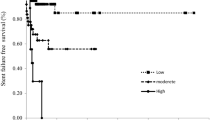Abstract
Purpose
The optimal management of malignant extrinsic ureteral obstruction (MUO) remains unclear. It is necessary to assess the patient prognosis in deciding the adaptation of drainage of renal pelvis. In this study, we investigated the clinical outcomes after ureteral stenting for MUO and the predictive factors for overall survival in order to create a risk-stratification model.
Methods
We retrospectively analyzed the clinical and laboratory data of 93 patients with radiologically significant hydronephrosis associated with MUO who underwent successful stent placement between May 2005 and May 2018.
Results
The median survival duration after the initial stent insertion was 266 days. Of the 93 patients, 70 died, and the median interval from the first stent insertion to death was 160 days. Multivariate analysis showed that gastric cancer as the primary disease, poor performance status before stenting, and treatment after stent insertion were significant predictors of survival. According to these three factors, we stratified patients into the following four prognostic groups: no-factor (43 patients), one-factor (23 patients), two-factor (23 patients), and three-factor (4 patients) groups. This classification was effective for predicting survival, and the median survival durations in these groups were 807, 269, 44, and 12 days, respectively (p < 0.001).
Conclusions
Our stratification model of patients with a poor prognosis after ureteral stent placement for MUO may allow urologists and clinicians to identify patients who will benefit from ureteral stenting.

Similar content being viewed by others
References
Turgut B, Bayraktar AM, Bakdık S, Hamarat MB, Öncü F, Gönen M, Tolu I (2019) Placement of double-J stent in patients with malignant ureteral obstruction: antegrade or retrograde approach? Clin Radiol 19:30379–30374
Allen DJ, Longhorn SE, Philp T, Smith RD, Choong S (2010) Percutaneous urinary drainage and ureteric stenting in malignant disease. Clin Oncol 22:733–739
Pavlovic K, Lange D, Chew BH (2016) Stents for malignant ureteral obstruction. Asian J Urol 3:142–149
Sountoulides P, Mykoniatis I, Dimasis N (2014) Palliative management of malignant upper urinary tract obstruction. Hippokratia. 18:292–297
Elsamra SE, Leavitt DA, Motato HA, Friedlander JI, Siev M, Keheila M, Hoenig DM, Smith AD, Okeke Z (2015) Stenting for malignant ureteral obstruction: tandem, metal or metal-mesh stents. Int J Urol 22:629–636
Ganatra AM, Loughlin KR (2005) The management of malignant ureteral obstruction treated with ureteral stents. J Urol 174:2125–2128
Kamiyama Y, Matsuura S, Kato M, Abe Y, Takyu S, Yoshikawa K, Arai Y (2011) Stent failure in the man-agement of malignant extrinsic ureteral obstruction: risk factors. Int J Urol 18:379–382
Yossepowitch O, Lifshitz DA, Dekel Y, Gross M, Keidar DM, Neuman M, Livne PM, Baniel J (2001) Predicting the success of retrograde stenting for managing ureteral obstruction. J Urol 66:1746–1749
Kanda Y (2013) Investigation of the freely available easy-to-use software ‘EZR’ for medical statistics. Bone Marrow Transplant 48:452–458
Ishioka J, Kageyama Y, Inoue M, Higashi Y, Kihara K (2008) Prognostic model for predicting survival after palliative urinary diversion for ureteral obstruction: analysis of 140 cases. J Urol 180:618–621
Cordeiro MD, Coelho RF, Chade DC, Pessoa RR, Chaib MS, Colombo-Júnior JR, Pontes-Júnior J, Guglielmetti GB, Srougi M (2016) A prognostic model for survival after palliative urinary diversion for malignant ureteric obstruction: a prospective study of 208 patients. BJU Int 117:266–271
Alawneh A, Tuqan W, Innabi A, Al-Nimer Y, Azzouqah O, Rimawi D, Taqash A, Elkhatib M, Klep-stad P (2016) Clinical factors associated with a short survival time after percutaneous nephrostomy for ureteric obstruction in cancer patients: an updated model. J Pain Symptom Manag 251:255–261
Azuma T, Nagase Y, Oshi M (2013) Prognostic marker for patients with malignant ureter obstruction. Clin Genitourin Cancer 11:353–356
Song Y, Fei X, Song Y (2012) Percutaneous nephrostomy versus indwelling ureteral stent in the management of gynecological malignancies. Int J Gynecol Cancer 22:697–702
Lienert A, Ing A, Mark S (2009) Prognostic factors in malignant ureteric obstruction. BJU Int 104:938–941
Jeong IG, Han KS, Joung JY, Seo HK, Chung J (2007) The outcome with ureteric stents for managing non-urological malignant ureteric obstruction. BJU Int 100:1288–1291
Ohtaka M, Kawahara T, Takamoto D, Mochizuki T, Hattori Y, Teranishi J, Makiyama K, Miyoshi Y, Yumura Y, Yao M, Uemura H (2018) Gastrointestinal cancer and bilateral hydronephrosis resulted in a high risk of ureteral stent failure. BMC Urol 18:35
Migita K, Watanabe A, Samma S, Ohyama T, Ishikawa H, Kagebayashi Y (2011) Clinical outcome and management of ureteral obstruction secondary to gastric cancer. World J Surg 35:1035–1041
Kulkarni R (2014) Metallic stents in the management of ureteric strictures. Indian J Urol 30:65–72
Wang JY, Zhang HL, Zhu Y, Qin XJ, Dai BO, Ye DW (2016) Predicting the failure of retrograde ureteral stent insertion for managing malignant ureteral obstruction in outpatients. Oncol Lett 11:879–883
Baumgarten AS, Hakky TS, Carrion RE, Lockhart JL, Spiess PE (2014) A single-institution experience with metallic ureteral stents: a cost-effective method of managing deficiencies in ureteral drainage. Int Braz J Urol 40:225–231
Zita Ficko and Elias S. Hyams (2018) Complications of upper tract drainage. in: Samir S. Taneja MD and Ojas Shah MD (ed) Complications of urologic surgery, 5th. Elsevier, New York, pp 218–225
Khoo CC, Abboudi H, Cartwright R, El-Husseiny T, Dasgupta R (2018) Metallic ureteric stents in malignant ureteric obstruction: a systematic review. Urology 118:12–20
Acknowledgments
We greatly thank the urologists enrolled in our hospital.
Author information
Authors and Affiliations
Corresponding author
Ethics declarations
Conflict of interest
The authors declare that they have no conflict of interest.
Additional information
Publisher’s note
Springer Nature remains neutral with regard to jurisdictional claims in published maps and institutional affiliations.
Rights and permissions
About this article
Cite this article
Matsuura, H., Arase, S. & Hori, Y. Clinical outcomes and prognostic factors associated with internal ureteral stent placement for malignant extrinsic ureteral obstruction. Support Care Cancer 28, 5743–5750 (2020). https://doi.org/10.1007/s00520-020-05413-0
Received:
Accepted:
Published:
Issue Date:
DOI: https://doi.org/10.1007/s00520-020-05413-0




